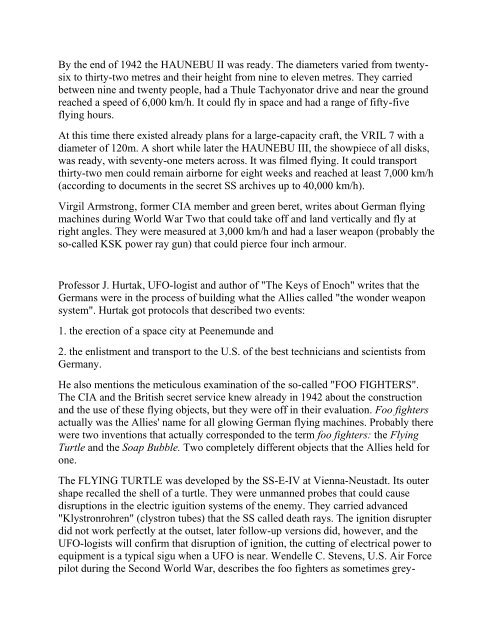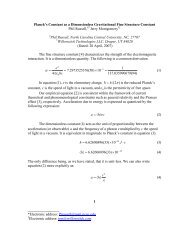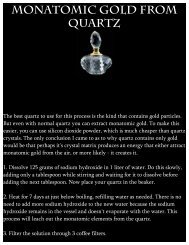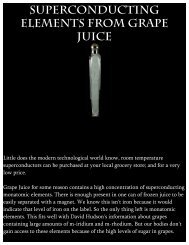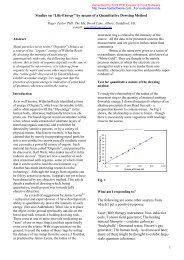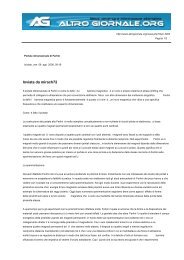Viktor Schauberger
Viktor Schauberger
Viktor Schauberger
Create successful ePaper yourself
Turn your PDF publications into a flip-book with our unique Google optimized e-Paper software.
By the end of 1942 the HAUNEBU II was ready. The diameters varied from twentysix<br />
to thirty-two metres and their height from nine to eleven metres. They carried<br />
between nine and twenty people, had a Thule Tachyonator drive and near the ground<br />
reached a speed of 6,000 km/h. It could fly in space and had a range of fifty-five<br />
flying hours.<br />
At this time there existed already plans for a large-capacity craft, the VRIL 7 with a<br />
diameter of 120m. A short while later the HAUNEBU III, the showpiece of all disks,<br />
was ready, with seventy-one meters across. It was filmed flying. It could transport<br />
thirty-two men could remain airborne for eight weeks and reached at least 7,000 km/h<br />
(according to documents in the secret SS archives up to 40,000 km/h).<br />
Virgil Armstrong, former CIA member and green beret, writes about German flying<br />
machines during World War Two that could take off and land vertically and fly at<br />
right angles. They were measured at 3,000 km/h and had a laser weapon (probably the<br />
so-called KSK power ray gun) that could pierce four inch armour.<br />
Professor J. Hurtak, UFO-logist and author of "The Keys of Enoch" writes that the<br />
Germans were in the process of building what the Allies called "the wonder weapon<br />
system". Hurtak got protocols that described two events:<br />
1. the erection of a space city at Peenemunde and<br />
2. the enlistment and transport to the U.S. of the best technicians and scientists from<br />
Germany.<br />
He also mentions the meticulous examination of the so-called "FOO FIGHTERS".<br />
The CIA and the British secret service knew already in 1942 about the construction<br />
and the use of these flying objects, but they were off in their evaluation. Foo fighters<br />
actually was the Allies' name for all glowing German flying machines. Probably there<br />
were two inventions that actually corresponded to the term foo fighters: the Flying<br />
Turtle and the Soap Bubble. Two completely different objects that the Allies held for<br />
one.<br />
The FLYING TURTLE was developed by the SS-E-IV at Vienna-Neustadt. Its outer<br />
shape recalled the shell of a turtle. They were unmanned probes that could cause<br />
disruptions in the electric iguition systems of the enemy. They carried advanced<br />
"Klystronrohren" (clystron tubes) that the SS called death rays. The ignition disrupter<br />
did not work perfectly at the outset, later follow-up versions did, however, and the<br />
UFO-logists will confirm that disruption of ignition, the cutting of electrical power to<br />
equipment is a typical sigu when a UFO is near. Wendelle C. Stevens, U.S. Air Force<br />
pilot during the Second World War, describes the foo fighters as sometimes grey-


